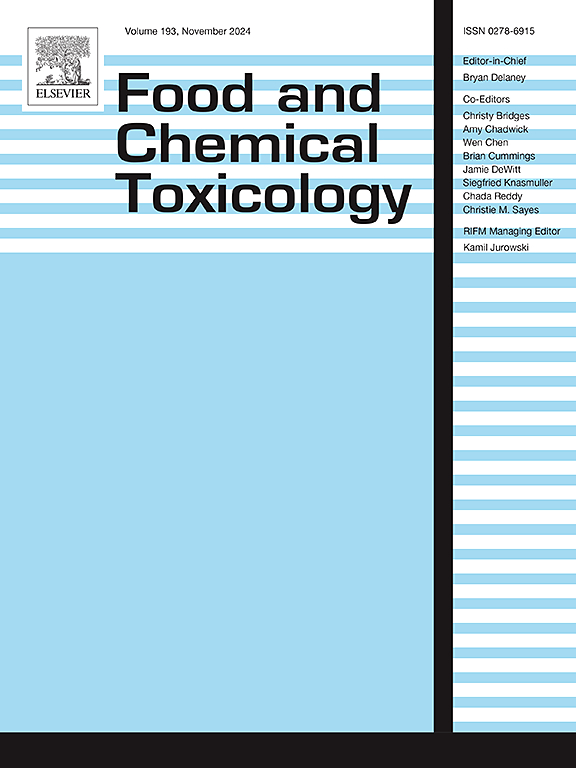雄性和雌性大鼠及小鼠对口服[14C]栀子蓝的吸收有限。
IF 3.9
3区 医学
Q2 FOOD SCIENCE & TECHNOLOGY
引用次数: 0
摘要
栀子蓝(GB)是一种广泛使用的植物性食用色素,是由玄甙的苷元与蛋白质水解物反应制备而成。最近有关 GB 毒性的动物研究表明,啮齿类动物通过饮食摄入 GB 后,胃肠道、肾脏和肠系膜淋巴结会呈现蓝色。本研究调查了雄性和雌性大鼠和小鼠通过灌胃给药 100 或 1000 毫克/千克[14C]GB 的吸收和处置情况。[14C]GB 是由 [2-14C]genipin 与大豆蛋白水解物反应制备而成。大鼠给药后,14C 主要通过粪便排出(占给药剂量的 89-97%),呼出的挥发性有机化学物质(VOC)和二氧化碳捕集器不含放射性,尿液中的 14C 含量为 0.2-0.4%。在胆管封闭的大鼠体内(100 毫克/千克 [14C]GB ),剂量的 0.25% 在胆汁中被回收,0.5% 在尿液中被回收。根据尿液、胆汁和胴体中的放射性减去消化道内容物,吸收的剂量百分比为 0.9%。组织中放射性水平最高的是肾脏;但肾脏的回收率很低,只有 0.02-0.04% 的剂量在肾脏中被回收。重复给药表明,14C 在肾脏中积累,并在停止给药后缓慢排出,这与之前的研究结果一致,且未出现任何功能或组织病理学变化。本文章由计算机程序翻译,如有差异,请以英文原文为准。
Limited uptake of [14C]Gardenia Blue administered orally in male and female rats and mice
Gardenia blue (GB), a widely used plant-derived food color is prepared by reaction of genipin, the aglycone of geniposide, with protein hydrolysate. Recent animal studies investigating GB toxicity have indicated blue coloration in the gastrointestinal tract, kidneys and mesenteric lymph nodes in rodents following dietary administration. This study investigated the uptake and disposition of [14C]GB in male and female rats and mice administered 100 or 1000 mg/kg by gavage. [14C]GB was prepared by reaction of [2–14C]genipin with soy protein hydrolysate. Following administration in rats, 14C was eliminated primarily in feces (89–97% of administered dose), exhaled volatile organic chemical (VOC) and CO2 traps contained no radioactivity, and urine contained 0.2–0.4 %. In bile-duct-cannulated rats (100 mg/kg [14C]GB), 0.25% of dose was recovered in bile, and in urine, 0.5%. The percent of the dose absorbed was 0.9%, based on radioactivity in urine, bile, and carcass minus digestive tract contents. The highest level of radioactivity in tissues was in kidney; however renal recovery was low, with only 0.02–0.04% of the dose recovered in kidney. Repeated dosing indicated that 14C accumulated in kidney, and was slowly removed following cessation of dosing, consistent with previous studies, in the absence of any functional or histopathological changes.
求助全文
通过发布文献求助,成功后即可免费获取论文全文。
去求助
来源期刊

Food and Chemical Toxicology
工程技术-毒理学
CiteScore
10.90
自引率
4.70%
发文量
651
审稿时长
31 days
期刊介绍:
Food and Chemical Toxicology (FCT), an internationally renowned journal, that publishes original research articles and reviews on toxic effects, in animals and humans, of natural or synthetic chemicals occurring in the human environment with particular emphasis on food, drugs, and chemicals, including agricultural and industrial safety, and consumer product safety. Areas such as safety evaluation of novel foods and ingredients, biotechnologically-derived products, and nanomaterials are included in the scope of the journal. FCT also encourages submission of papers on inter-relationships between nutrition and toxicology and on in vitro techniques, particularly those fostering the 3 Rs.
The principal aim of the journal is to publish high impact, scholarly work and to serve as a multidisciplinary forum for research in toxicology. Papers submitted will be judged on the basis of scientific originality and contribution to the field, quality and subject matter. Studies should address at least one of the following:
-Adverse physiological/biochemical, or pathological changes induced by specific defined substances
-New techniques for assessing potential toxicity, including molecular biology
-Mechanisms underlying toxic phenomena
-Toxicological examinations of specific chemicals or consumer products, both those showing adverse effects and those demonstrating safety, that meet current standards of scientific acceptability.
Authors must clearly and briefly identify what novel toxic effect (s) or toxic mechanism (s) of the chemical are being reported and what their significance is in the abstract. Furthermore, sufficient doses should be included in order to provide information on NOAEL/LOAEL values.
 求助内容:
求助内容: 应助结果提醒方式:
应助结果提醒方式:


